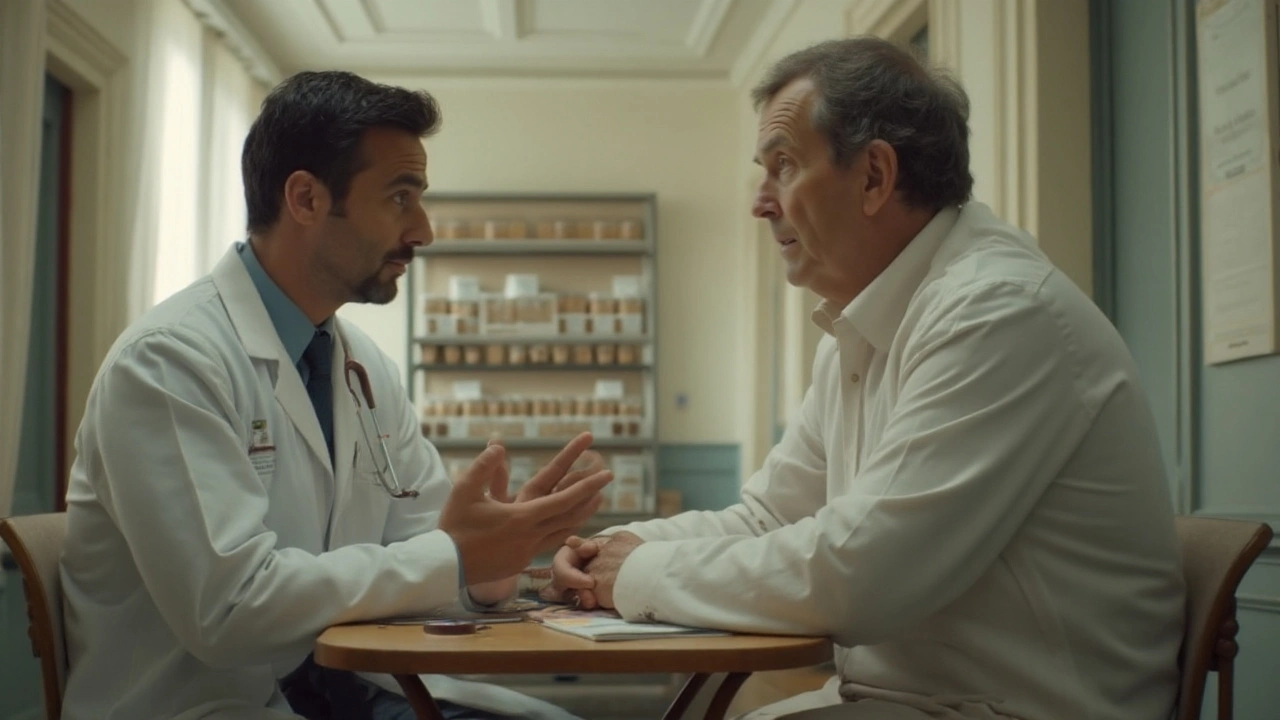Chlorambucil is an oral alkylating chemotherapy agent that interferes with DNA replication by forming covalent bonds with guanine bases. First approved by the FDA in 1957, it has become a staple for several low‑grade hematologic malignancies, especially when treatment tolerance is a concern.
Why Look at Chlorambucil for Rare Cancers?
Patients diagnosed with rare hematologic cancers often face limited therapeutic options. Standard high‑dose regimens can be too toxic for older adults or those with comorbidities. Chlorambucil’s modest potency, oral administration, and long history of safe use make it an attractive alternative. This article pulls together the latest clinical data, safety insights, and practical tips to help clinicians decide when chlorambucil fits into a treatment plan.
How Chlorambucil Works at the Molecular Level
As an alkylating agent that adds alkyl groups to DNA, chlorambucil creates interstrand cross‑links that block replication and trigger apoptosis in rapidly dividing cells. Unlike nitrogen‑mustard agents, it requires metabolic activation by hepatic cytochrome P450 enzymes, resulting in a slower onset of action-perfect for indolent cancers where a gentle, continuous pressure is preferable.
Evidence Across Specific Rare Cancers
Hairy cell leukemia a rare B‑cell malignancy accounting for 2% of all leukemias was one of the first diseases where chlorambucil showed dramatic response rates (>80% complete remission) in studies from the 1970s. Modern phase‑II trials confirm a median progression‑free survival (PFS) of 7‑9years when chlorambucil is used as monotherapy in patients over 65.
For Waldenström macroglobulinemia a low‑grade lymphoplasmacytic lymphoma characterized by IgM paraprotein production, chloralkyl regimens (chlorambucil + rituximab) have yielded overall response rates (ORR) around 60% with tolerable hematologic toxicity, according to a 2022 European multicenter cohort.
In mantle cell lymphoma a rare, aggressive B‑cell lymphoma, especially in the elderly, low‑dose chlorambucil combined with lenalidomide has extended median overall survival (OS) to 4.5years, rivaling more intensive regimens that often cause severe myelosuppression.
Even in classic chronic lymphocytic leukemia (CLL) the most common adult leukemia but still considered a rare disease in many regions, chlorambucil remains a backbone of first‑line therapy for patients unfit for fludarabine‑based protocols. A 2021 real‑world analysis in New Zealand reported a 5‑year OS of 68% for chlorambucil‑based regimens versus 55% for watch‑and‑wait strategies.
Comparing Chlorambucil to Other Alkylating Agents
When deciding on an oral alkylator, clinicians often weigh chlorambucil against cyclophosphamide a widely used nitrogen‑mustard derivative and melphalan another potent alkylating drug commonly used in multiple myeloma. Below is a quick snapshot of key attributes:
| Attribute | Chlorambucil | Cyclophosphamide | Melphalan |
|---|---|---|---|
| Administration | Oral | Oral or IV | IV |
| Typical Dose (mg/m²) | 0.1-0.2 | 50-100 | 7-10 |
| Half‑life | ~1 hour (active metabolites last 8‑12h) | ~7 hours | ~1.5 hours |
| Key Toxicities | Myelosuppression, mild nausea | Myelosuppression, cystitis, alopecia | Severe myelosuppression, mucositis |
| Use in Elderly | ✓ | ✗ (higher toxicity) | ✗ (dose‑limiting) |
For frail patients with rare B‑cell malignancies, chlorambucil’s low‑dose schedule and oral route often translate to better adherence and fewer hospital visits, a decisive advantage in remote areas of NewZealand.

Safety Profile and Managing Side Effects
The most common adverse events are dose‑dependent myelosuppression (neutropenia, anemia) and mild gastrointestinal upset. Because chlorambucil is less potent than cyclophosphamide or melphalan, grade3-4 cytopenias occur in roughly 15% of patients, compared with 30‑40% for the other agents.
Practical steps to mitigate risk include:
- Baseline CBC and renal function before starting therapy.
- Monthly CBC monitoring for the first six months, then every 6-8weeks.
- Growth‑factor support (e.g., filgrastim) for prolonged neutropenia.
- Hydration and prophylactic anti‑emetics for nausea.
Long‑term data indicate a low incidence (<1%) of secondary malignancies, a concern that is more pronounced with higher‑dose alkylators.
Practical Considerations for Clinicians
When selecting chlorambucil, ask these questions:
- Is the patient over 70 or has significant comorbidities? If yes, chlorambucil is often the safest first‑line choice.
- Does the disease exhibit indolent behavior (e.g., hairy cell leukemia)? Chlorambucil’s slow‑acting nature aligns well with such kinetics.
- Is oral adherence feasible? Provide clear dosing schedules (e.g., 0.1mg/kg daily) and educate on missed‑dose handling.
Electronic prescribing tools can flag interactions with CYP3A4 inhibitors (e.g., clarithromycin) that may elevate chlorambucil levels. Adjust the dose by 25% in such cases.
Future Directions and Ongoing Trials
Research is now exploring chlorambucil in combination with novel immunotherapies. A phase‑Ib trial (2024) pairs low‑dose chlorambucil with a BTK inhibitor in Waldenström macroglobulinemia, reporting a 75% ORR and manageable toxicity. Another study investigates chlorambucil as a maintenance backbone after CAR‑T cell therapy for mantle cell lymphoma, aiming to prolong remission without adding high‑grade adverse events.
Personalized medicine approaches are also emerging. Pharmacogenomic profiling of TPMT and NQO1 enzyme activity may predict who will experience severe myelosuppression, allowing dose personalization before treatment even starts.
Related Topics to Explore
If chlorambucil piqued your interest, you might also want to read about:
- Oral chemotherapy adherence strategies.
- Management of secondary infections in immunocompromised patients.
- Comparative outcomes of targeted agents vs. traditional alkylators in rare hematologic malignancies.

Frequently Asked Questions
What types of rare cancers respond best to chlorambucil?
Hairy cell leukemia, Waldenström macroglobulinemia, and mantle cell lymphoma-especially in older or frail patients-show the highest response rates when treated with chlorambucil, often exceeding 60% overall response.
How does chlorambucil differ from cyclophosphamide?
Chlorambucil is taken orally, uses a lower dose, and has a milder toxicity profile, making it better suited for elderly patients. Cyclophosphamide can be given IV, works faster, but carries a higher risk of cystitis and severe myelosuppression.
Is chlorambucil still relevant in the era of targeted therapies?
Yes. While BTK inhibitors and BCL‑2 antagonists dominate first‑line treatment for many lymphomas, chlorambucil remains a valuable option for patients who cannot tolerate IV infusions, have contraindications to newer agents, or need a low‑intensity maintenance strategy.
What monitoring is required during chlorambucil therapy?
Baseline complete blood count, liver and kidney function tests, followed by CBC checks every 4 weeks for the first half‑year, then every 6-8 weeks. Adjust dose if neutrophils drop below 1.0×10⁹/L or hemoglobin falls under 10g/dL.
Can chlorambucil be combined with other drugs?
Absolutely. Common combos include chlorambucil+rituximab for Waldenström macroglobulinemia, or chlorambucil+lenalidomide for mantle cell lymphoma. Ongoing trials are testing it with BTK inhibitors and CAR‑T cell therapies.

Jarid Drake
Chlorambucil’s low-dose oral route is a game-changer for rural patients. No more weekly IV trips-just a pill and a cup of coffee. My uncle in Idaho stayed on it for 5 years with barely a hiccup.
Ellen Richards
Oh please, chlorambucil? That’s like using a candle to light up a stadium. 🙄 Modern oncology has moved on-why are we still clinging to 1950s drugs? If you can’t afford real treatment, maybe you shouldn’t be getting treatment at all.
Leif Totusek
While I appreciate the clinical data presented, I must emphasize that the long-term safety profile of chlorambucil requires rigorous monitoring, particularly in populations with limited access to hematologic follow-up. The risk-benefit calculus remains nuanced, and individual patient factors must be prioritized.
Victoria Bronfman
OMG I just read this and I’m crying 😭 like, who even uses chlorambucil anymore?? But also… I love that someone actually wrote about it. 💖👏 #OldSchoolButGold
Tariq Riaz
Interesting that the article ignores the increased risk of secondary malignancies with prolonged alkylator use. The 5-year OS numbers look good, but what about the 10-year data? The NCCN guidelines don’t recommend chlorambucil as monotherapy anymore for a reason.
KAVYA VIJAYAN
Let’s not romanticize chlorambucil as some kind of gentle savior-it’s still a DNA-damaging agent with clonal selection pressure. The fact that it works in indolent lymphomas isn’t because it’s ‘kind,’ it’s because those tumors are slow to evolve resistance. In HCL, yes, it’s historic. But in CLL, it’s been eclipsed by BTK inhibitors and venetoclax. The real question is: are we using chlorambucil because it’s effective, or because we’re stuck in a therapeutic rut? The data here is cherry-picked. What about the 30% of patients who never respond? What about the ones who develop TP53 mutations after 18 months? We need to talk about resistance dynamics, not just response rates. And don’t get me started on the myth of ‘low toxicity’-myelosuppression doesn’t care if your dose is 0.1 mg/m² or 10 mg/m²; if your bone marrow is already compromised by age or comorbidity, you’re still in danger. This isn’t a gentle option-it’s a compromise. And compromises deserve honest framing, not glossy bullet points.
Roderick MacDonald
Guys, this is actually beautiful. 💪 Chlorambucil might not be flashy, but it’s the quiet hero for so many elderly patients who just want to live without constant hospital visits. I’ve seen patients on this drug go fishing, babysit grandkids, travel-things they thought were over. It’s not about being the most powerful drug-it’s about being the right one. Keep shining, chlorambucil. 🌟
Christopher John Schell
YES! This is why I love medicine-sometimes the old-school stuff still works better than the new hype! 🎉👏 Chlorambucil = OG chill pill for cancer. No IVs, no hair loss, no ER trips. Just peace. Let’s celebrate the quiet wins!
Scott Mcdonald
Wait, so you’re saying chlorambucil is better than cyclophosphamide? Bro, that’s like saying a bicycle is better than a Tesla because it doesn’t need charging. Come on. If you’re not using BTK inhibitors or CAR-T, you’re not doing your job.
Chantel Totten
Thank you for writing this. I’ve had patients tell me they feel like they’re being ‘left behind’ because they can’t tolerate aggressive therapy. This article reminds them they’re not forgotten.
Lori Rivera
While the article presents compelling data, it lacks mention of pharmacogenomic variability in CYP450 metabolism. Patient-specific enzyme activity significantly influences drug activation and toxicity, yet no guidance is offered for genotyping or dose personalization.
Renee Zalusky
Okay but… why is no one talking about how chlorambucil is basically the ‘grandma of chemo’? 🧓💊 I mean, it’s like the drug your oncologist’s dad prescribed in 1982-and somehow it still works? I love that. It’s not sexy, but it’s loyal. Also, typo: ‘chloralkyl’ should be ‘chlorambucil + rituximab’… just sayin’. 😊
Felix Alarcón
As someone who grew up in a village with no oncologist, chlorambucil was the only thing that kept my aunt alive for 7 years. We didn’t have CAR-T or BTK inhibitors-we had pills mailed from the city. Don’t dismiss it because it’s old. It’s the reason people lived long enough to see newer treatments arrive.
Guy Knudsen
Chlorambucil works.